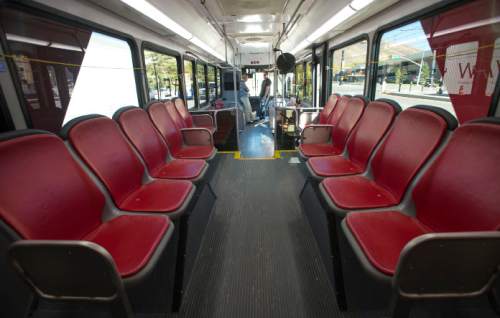This is an archived article that was published on sltrib.com in 2015, and information in the article may be outdated. It is provided only for personal research purposes and may not be reprinted.
If voters approve a sales-tax hike, the Utah Transit Authority is looking at using the extra money to increase the frequency of buses and trains, expand nighttime and weekend service, and shorten traveling time with, perhaps, more express routes.
And because UTA is spending less than budgeted so far this year, it is bringing a taste of those benefits early — upping service on key routes now and offering riders some deep but temporary fare discounts of up to 40 percent.
Administrators outlined those proposals Wednesday to the UTA Board and said they are also discussing them with cities and counties.
That comes as the Legislature this year passed a law to allow counties to ask voters to approve raising sales taxes by a quarter-cent on every $1 spent to go toward transportation.
In areas served by UTA, the law would divvy a tenth-cent to the transit agency and the rest would go to cities and counties for local roads.
The timing of such elections has not been determined, but could come as early as November in some counties. However, some counties have said they are considering delaying that at least a year to focus on other tax and township ballot issues now — and allow extra time to build public support for the transportation tax.
If the tax hike is approved, it could increase UTA's budget by an estimated 13 percent, said Jerry Benson, vice president for operations.
He said most requests, or complaints, UTA receives seek more frequent service, extending it later into the night and on weekends, shortening travel time (including more express service) and expanding where routes travel. He said the agency is looking at doing a bit of each if voters approve the tax boost.
He gave an example of what could be done with the tenth-cent increase, but stressed it is only an idea and far from final.
It could increase the number of bus routes that offer service every 15 minutes by 30 percent.
For TRAX to the airport, it could provide a 15 percent service boost on weekdays and a 20 percent bump on weekends. It could increase the number of bus routes that run until midnight from one to 19, he said.
UTA also announced that it decided to give riders a taste of such upgrades now and will offer some fare discounts because it has managed to operate under budget so far this year.
"We achieved enough savings that we are able to invest in service beyond what we had already planned for our upcoming [schedule] change day" on Aug. 16, said UTA President and CEO Michael Allegra.
That includes extending through Dec. 31 a current 20 percent discount on fares for those who use UTA's new electronic FAREPAY card. That discount, which allows a one-way trip for $2 instead of $2.50, was scheduled to expire in June.
Besides that, UTA will offer a 40 percent discount for those using a FAREPAY card and travel just on local buses, and not other rail services — lowering a one-way fare to $1.50.
"Our new technology allows us to do that," Allegra said, and tell when a rider is just using a bus.
That discount will be offered beginning July 1 and will continue through Dec. 31.
During the same period, UTA will offer a group pass for $10, instead of the current $15. It allows up to four people to make a round trip on buses, TRAX and FrontRunner between 8:30 a.m. and midnight on the day of purchase.
Also effective Aug. 16, UTA will extend Sunday hours on TRAX to match its Saturday hours. The agency will increase the hours of operation for the Sugar House Streetcar to match TRAX, seven days a week.
Two bus routes will increase frequency to 15 minutes all day: Route 54 (along 5400/5300 South from Murray to Kearns), and Route 220 (along Highland Drive from Sandy to Salt Lake City).
Route 2X to the University of Utah from the Salt Lake City Central Station will add seven morning express trips daily.
Saturday frequency will be increased to every 15 minutes on Route 612 (on Washington Boulevard in Ogden) and Route 603 (from the Ogden Transit Center to Weber State University).
Finally, Route 612 — which runs from the Ogden Transit Center to downtown Salt Lake City — will have its Saturday frequency increased to every 30 minutes.



